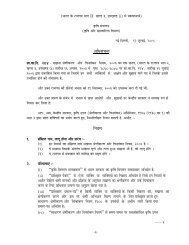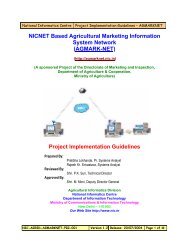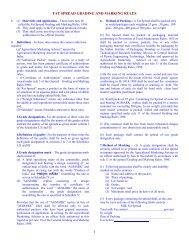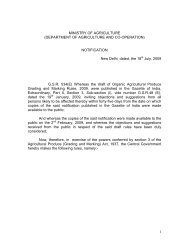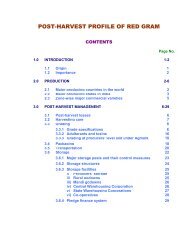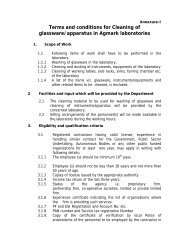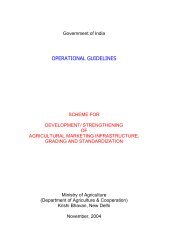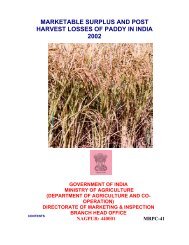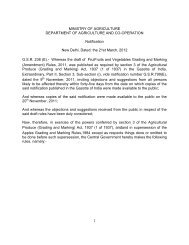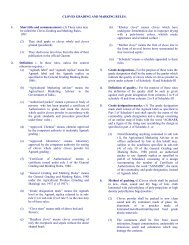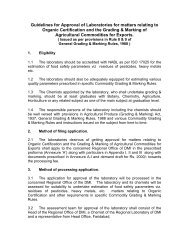(Cold Storages) of Rajasthan - Agmarknet
(Cold Storages) of Rajasthan - Agmarknet
(Cold Storages) of Rajasthan - Agmarknet
You also want an ePaper? Increase the reach of your titles
YUMPU automatically turns print PDFs into web optimized ePapers that Google loves.
Ha numa n Ga rhJhunjunu, SikarJa isa lmer, Na goreDosa, TonkSa wa i Ma d hop urBhilwa ra, Ja loreRajsamand, ChittorgarhBa ra , Dung a rp urBa nswa ra , Ka roliBarmer, Churu, Jaisalmer, JhalawarPali, DholpurSri Ganganagar,Bikaner, KotaAjmer, UdaipurAlwarJaipur, Jodhpur, BharatpurNo <strong>Cold</strong> Storage CapacityUnder CapacityBorder Line CapacitySound CapacityOver Capacity
and notices. You agree to comply with all local rules applicable to you in your use <strong>of</strong>the Program. You agree not to reproduce, resell or exploit for any commercialpurposes, any portion <strong>of</strong> the Program. If you violate any <strong>of</strong> these terms, yourpermission to use the Program automatically terminates.4.3. The Program is provided solely for lawful purposes and use. You agree to superviseand control the use <strong>of</strong> the Program in accordance with the terms <strong>of</strong> this Agreement.You shall be solely responsible for, and agree to comply with, all laws, statutes,ordinances, regulations, rules and other government authority ('Laws') applicable tothe use <strong>of</strong> the Program. The Program is provided subject to this standardcommercial agreement and qualifies as commercial computer s<strong>of</strong>tware within themeaning <strong>of</strong> the applicable government acquisition Laws.4.4. THIS LICENSE AGREEMENT IS EXPRESSLY MADE SUBJECT TO ANY LAWS,REGULATIONS, ORDERS, OR OTHER RESTRICTIONS ON THE EXPORT FROMTHE UNITED STATES OF AMERICA OF THE PROGRAM OR INFORMATIONABOUT SUCH PROGRAM WHICH MAY BE IMPOSED FROM TIME TO TIME BYTHE GOVERNMENT OF THE UNITED STATES OF AMERICA. YOU SHALL NOTEXPORT THE PROGRAM OR INFORMATION ABOUT THE PROGRAM TO ANYCOUNTRY WHERE THE UNITED STATES REQUIRES AN EXPORT LICENSEWITHOUT CONSENT OF COMODO AND THEN ONLY IN COMPLIANCE WITHSUCH LAWS, REGULATIONS, ORDERS, OR OTHER RESTRICTIONS.4.5. The terms and conditions <strong>of</strong> this Agreement shall apply to your use and disclosure <strong>of</strong>the Program, and shall supersede any conflicting contractual terms and conditions.If this Agreement fails to meet your minimum needs or is inconsistent in any respectwith government procurement Laws, you agree not to use the Program.5. Disclaimer <strong>of</strong> Warranties5.1. THE PROGRAM IS PROVIDED TO YOU “AS IS” BY COMODO, AND ANY USE BYYOU OF THE PROGRAM IS AT YOUR OWN RISK. YOU ACKNOWLEDGE THATTHE PROGRAM MAY CONTAIN BUGS, ERRORS, AND OTHER PROBLEMSTHAT COULD CAUSE SYSTEM OR OTHER FAILURES AND DATA LOSS.COMODO DOES NOT WARRANT THE PERFORMANCE OF THE PROGRAM ANDDOES NOT WARRANT THAT THE PROGRAM WILL OPERATE SUBSTANTIALLYIN ACCORDANCE WITH THE DOCUMENTATION ACCOMPANYING THEPROGRAM. COMDOO DOES NOT WARRANT THAT THE PROGRAM WILLPROTECT THE DISK FROM BEING CHANGED OR THAT ANY CHANGES MADETO A DISK WILL BE REVERTED TO THE ORIGINAL STATE. SOME FILES MAYNOT BE RESTORED OR REMOVED UPON A SYSTEM RESTART DESPITE THEINTENDED OPERATION OF THE PROGRAM.5.2. TO THE MAXIMUM EXTENT PERMITTED BY LAW, COMODO DISCLAIMS ALLWARRANTIES OF ANY KIND, WHETHER EXPRESSED OR IMPLIED, IN EQUITYOR AT LAW, INCLUDING, WITHOUT LIMITATION, IMPLIED WARRANTIES OFMERCHANTABILITY, FITNESS FOR A PARTICULAR PURPOSE, AND NON-INFRINGEMENT. COMODO DOES NOT WARRANT THAT THE FUNCTIONS
MASTER PLAN FOR RAJASTAN STATE COLD STORAGEINTRODUCTIONThe land <strong>of</strong> vibrant colours, known for its valiance and chivalry. <strong>Rajasthan</strong>has an unusual diversity in all its forms – people, customs, culture, costumes, music,manners, dialects, cuisine and physiography. The panoramic outlook <strong>of</strong> the state issimply mesmerizing, with l<strong>of</strong>ty hills <strong>of</strong> Aravali’s – one <strong>of</strong> the oldest mountainranges <strong>of</strong> the world and the golden sand dunes <strong>of</strong> the Great Indian Desert – the onlydesert <strong>of</strong> the sub continent.No other region in the country is a conglomeration <strong>of</strong> so many paradoxes andendowed with invincible forts, magnificent palaces havelis, rich culture andheritage, natural beauty and natural resources.Indologists have traced the antiquity <strong>of</strong> this wonderland back to earl stone age. Itsruins, relic and romances speaks <strong>of</strong> the vicissitudes through which it has gonethrough, embracing dozens <strong>of</strong> centuries full <strong>of</strong> glorious moments and alsoreminding the tragic and turbulent past. <strong>Rajasthan</strong> is a permanent bastion <strong>of</strong> Indianculture and spirituality.This treasure house <strong>of</strong> history is also known for its arts and crafts. This exotic landis a treasure trove <strong>of</strong> handicrafts and a shoppers paradise. In concept, colours andcraftsmanship the handicrafts <strong>of</strong> the state are unparalleled. Be it jewellery,paintings, metal craft, hand-printed textiles, leather craft, pottery, wood carving etc.each object has a subtle and overpowering appeal. A ethnic aura engulfs even thesimplest <strong>of</strong> forms, making each one truly a collectors delight.1
<strong>Rajasthan</strong> is also known for its folk musical instruments and folk musicians. Thefolk music is a multifaceted kaliedoscope, from the simple Ghoralio and theelementary Bhapang to the intricate Sarangi and formidable Bam-it is a wholeworld <strong>of</strong> rich and robust iridescene. The desert regions <strong>of</strong> the state are specially richin folk music, particularly in communities are Mirasis, Dhadhis, Langas,Manganiyars, Kalbelias (snake charmers), jogis, sargadas, Kamads, Nayaks orThoris and the Bhawaris.<strong>Rajasthan</strong> is a haven for a wide spectrum <strong>of</strong> wildlife. It is a home to tigers, blackbucks, chinkara, rare desert fox, endangered caracal, the great Indian bustard,gavial, monitor lizard etc. The state also attracts many migratory birds like thecommon cranes, ducks, coots, pelicans, rare Siberian cranes, demoiselle crane,imperial sandgrouse, falcons, buzzards… which appear annually in the various parts<strong>of</strong> the state.The festival time in the state is full <strong>of</strong> life and zest, the ambience acquire a fairytalelikeatmosphere. The colorfully dressed women adorned with their best jewelleryand menfolk with exotic turbans join the celebrations.Today <strong>Rajasthan</strong> is keeping pace with the changing time, and experiencing allround development in the fields <strong>of</strong> education, industry and agriculture.2
AGRICULTURENet area sown : 15,605.700 HAGross cropped area : 17, 902,900 HAArea under fruit crops : 2066140 HAProduction <strong>of</strong> fruit crops : 238034 TONNESArea under potato crop : 2412 HAProduction <strong>of</strong> Potato : 27797 TONNESFRUIT CROPSComing to horticultural produce the details (area and production) <strong>of</strong> Mango, Guava,Lime, Pomegranate, Jamun, Amla, Papaya, Phalsa, Orange, Ber, Mulbery, Grape,Sapota and Custard Apple, with regards to <strong>Rajasthan</strong> agriculture are given below: -AREA AND PRODUCTION OF FRUITS CROPSFruit Crop Area (Hect) Production (Qtls)Mango 6493 984934Guava 1885 226119Lime 2845 182060Pomegranate 382 10077Jamun 252 19091Amla 396 22192Papaya 374 33941Phalsa 48 4539Orange 5101 342550Ber 736 46608Mulberry 29 1689Grape 20 1238Sapota 11 257Custard Apple 255 5554
Total area under fruit crops is 2066140HA with production <strong>of</strong> 2380349 qtls in<strong>Rajasthan</strong>. Every type <strong>of</strong> fruit crops are grown in the state. Mango, Orange, Limeand Guava occupy the maximum area under fruit crop cultivation. In terms <strong>of</strong>agricultural produce yield, Mango is on the top followed by Orange, Guava andLime. Majority <strong>of</strong> agricultural crops grown here are irrigated by Indira GandhiCanal among different districts <strong>of</strong> Rajastan state, Udaipur district has maximumarea under orange cultivation, cultivation followed by Chittore district, Jhalawerdistrict has the area with maximum production in Lime cultivation followed byKota district, Bharatpur district has maximum area and production followed byAlwar district While Dholpur district has maximum area and production <strong>of</strong>goosebeni followed by Bundi district <strong>of</strong> the state.Area and production <strong>of</strong> various fruit crops in <strong>Rajasthan</strong> state during 1999-2000,2000-2001 and 2001-2002 has been stated in Table No. 3, 4 & 5. (Annexure )POTATOPotato is the crop, which is grown in every part <strong>of</strong> the <strong>Rajasthan</strong> state. Total areaunder potato crop in <strong>Rajasthan</strong> is 2412 Hectares with a production <strong>of</strong> 27797 tonnes.Bharatpur region has the maximum area (1442 ha) under potato crop. Sri GrangaNagar Region is the second largest region <strong>of</strong> the state for potato production. Thearrival <strong>of</strong> Potato in the different mandi <strong>of</strong> <strong>Rajasthan</strong> state has been stated in TableNo. 2. (Annexure)SEASONABILITY OF POTATO STORAGEIncreased by a factor <strong>of</strong> ten since 1960 and potato cultivation is one <strong>of</strong> the mostdynamic sectors <strong>of</strong> the Indian agricultural economy. More than 80% <strong>of</strong> Indianpotatoes produced on the Indo-Gangetic plain, an area that has seen rapid growth in5
horticultural production in the past decade. The expansion <strong>of</strong> high valued cropproduction has helped sustained agricultural growth in this region following thediffusion <strong>of</strong> high yielding cereal varieties in the 1960’s and 1970’s. Potatoesproduced in the plains are grown as a winter crop on irrigated land usually inrotation with cereals. Most <strong>of</strong> the crops are harvested between January and Marchwith a smaller early crop harvested in November and December. As production hascontinued to increase rapidly over time, the sheer volume <strong>of</strong> tubers at harvestcurrentlythe better part <strong>of</strong> nearly 20 million tons <strong>of</strong> potatoes puts considerablepressure on existing marketing infrastructure, which must absorb supplies comingout <strong>of</strong> the field over a period <strong>of</strong> 8 to 10 weeks. Between April and October potatodemand is met mainly through storage, except few relatively small summer cropharvested in plateau and hill regions.Some farmers hire space in cold stores and store their potatoes for sale later in theend <strong>of</strong> the season. While others sells their crops to traders or store owners whoundertake storage. <strong>Cold</strong> Storage provides a means <strong>of</strong> storing potatoes for the eightmonths. I.e., just prior to the harvest <strong>of</strong> the early crop in the case <strong>of</strong> table potatoes orplanning <strong>of</strong> the main crop in the case <strong>of</strong> seed. Depending on price movements (orexpectations), stored.Potatoes may be taken out and sold any time during the storage season. Similarly,depending on comparative supply and demand conditions, some the potatoes maybe re-graded and re-bagged, then sold (partly as table potatoes and partly ascommon seed).Many potato farmers, especially small farmers, store a portion <strong>of</strong> their crop (from afew kilos to several tons) under ambient conditions. Such ‘rustic’ storage involvesplacing loose potatoes in a shaped heap in the field or in a storehouse, covering thetubers with straw, hauls, or other handy material to provide insulation. Some6
farmers prefer to keep their potatoes in bags or in earthen pots inside the farmhouseitself to prevent damage from the elements or theft. Rustic farm storage is used tokeep potatoes for only two or three months. Rising temperatures and humidity preemptcontinuation <strong>of</strong> such practices beyond late April or early May. Tubers kept insuch fashion are used either for delayed, on-farm consumption or for sale as tablepotatoes.POTATO PRODUCTION AND PRICINGAs we see potatoes are grown as a short-duration winter crop between the mainsummer and fall cereal crops throughout the Indo-Gangetic plain <strong>of</strong> India. Theexpansion <strong>of</strong> potato production since the 190s has been made possible by severalfactors. These includes the increased availability <strong>of</strong> high quality seed due todevelopment <strong>of</strong> the ‘seed plot technique’ which significantly reduced increasetransmission; the breeding and diffusion <strong>of</strong> high yielding potato varieties theexpansion <strong>of</strong> cold storage facilities and the introduction <strong>of</strong> short duration cerealvarieties that are incentives to day length. These cereal varieties unable new, cerealpotatomultiple cropping system to be developed in irrigated areas. Advanced potatoproduction technology and availability <strong>of</strong> adequate cold storage capacity made highyielding, decrease-free seed, available on a much larger scale than was previouslypossible. Expansion <strong>of</strong> cold storage capacity also encouraged further production byextending the market for table potatoes in the <strong>of</strong>f-season.POTATO CONSUMPTIONThe potato is the most important vegetable in the Indian diet. As per record percapita consumption, although modest compared industrial countries, has increasedto 12.9 kg/cap/yrs from 4.1 kg/cap/yr in 1961-63. traditionally, the bulk potatoconsumption took place in the country side close to the centers <strong>of</strong> production.7
However, with the growth <strong>of</strong> Indian economy, rapid urbanization, and with theemergence <strong>of</strong> a relatively affluent middle class <strong>of</strong> some 200 million consumers, thepotato has enhanced its position as a high preferred, even high status vegetable.Many <strong>of</strong> these more affluent consumers are located in urban areas and overtime,they have come to perceive the potato as part <strong>of</strong> their regular diet.The growth in potato consumption has been further augment by the recentemergence <strong>of</strong> a snack and fast food sector catering to processed potatoes. Foodprocessors are increasingly eager to produces adequate quantities <strong>of</strong> good qualitypotatoes throughout the calendar year in order to supply their plants and facilities.The continues need <strong>of</strong> industry have added to pressures on the marketing system tosupply potatoes on a regular basis.MARKET STRUCTURE, STORAGE AND GOVERNMENT POLICYThe vast majority <strong>of</strong> potato producers in northern India are small farmers. Forexample, as a farm survey conducted in the mid-1980’s found that over half thegrowers contacted plant a hectare or less to he crop, and another 30% cultivatedbetween one and two hectares.Potatoes are a cash crop even for the smallest <strong>of</strong> potato farmers, Growers usuallyconsume part <strong>of</strong> what they produce and still market-either at or after harvest-over50% <strong>of</strong> their output since with irrigation and improved production technology,average yield have increase from 7 to 16 t/ha since 1960. Given the strong pr<strong>of</strong>itmotive <strong>of</strong> grovers and run up in prices after the main harvest, nearly all potat<strong>of</strong>armers are interested in storing some or what they harvest either in cold storage orin rustic storage or both. Certainly some if not all would prefer cold storage becauseit can be highly pr<strong>of</strong>itable as growers’. In recent years, however farmers haveexpressed increasing dissatisfaction with cold storage <strong>of</strong> potatoes for a variety <strong>of</strong>reasons.8
In some districts and states, growth in cold storage capacity has not been able tokeep pace with the increase in potato production. Under these circumstances,farmers may either have to pay much higher rental rates for space in a cold store orabsorb high transportation expenses to find storage space in other areas, if storagespace can be found at all. Frequent power cuts and shortages mean that growers runthe risk <strong>of</strong> heavy losses despite having actually secured and paid for cold storagespace. Growers have also reported that hey were not compensated forlosses/damage occurred to the potatoes in cold stores. Further they were chargedmore by cold storage operators. They <strong>of</strong>ten could not borrow money for using thepotatoes kept in the cold store as collateral, and that if they could borrow, it wasonly at exorbitant interest rates based on grower declarations that they typicallystore from 1,000 to 20,000 kg. Their numbers may be anywhere from 100 to 500per cold store. Hence, some growers feel that regardless <strong>of</strong> government regulation<strong>of</strong> the cold storage industry, given them relative numbers and that owner worktogether in state wise associations they have relatively little bargaining power innegotiations with cold store owners over terms and conditions, as some cold storageowners contained that they are merely scapegoat for breakdowns and bottlenecks inthe marketing system.POST HARVEST MANAGEMENTField crops play a major role in the Indian economy as they meet our food, feed andfiber requirements, besides, being the source <strong>of</strong> income and employment for about650 million farm families. India has made impressive progress in production <strong>of</strong>crops during the last 5 decades, culminating in self –sufficiency in many andsurplus in some crops. Fruits and vegetables, both fresh and processed formsprovide vital our diet, nutrients in their. Their high productivity per unit areacompared with cereal crops, provide much better economic returns if properly9
managed besides serving a good source <strong>of</strong> foreign-exchange earnings andemployment generation.Although India has attained new heights in the production <strong>of</strong> fruits comparable toBrazil and the USA and in vegetables to China, necessary measures are required toincrease production <strong>of</strong> fruits and vegetables to meet the basic nutritionalrequirements <strong>of</strong> our increasing population. Alternatively, this problem can beovercome by salvaging our proportion <strong>of</strong> the post-harvest losses in these perishableswhich amount to 20-40% <strong>of</strong> the total production with a net value <strong>of</strong> Rs. 50,000.00 -60,000.00 million. These losses occur at several stages in the post-harvestmanagement viz harvesting, grading, packing, transport, storage and marketing.Since the cost <strong>of</strong> conservation requires less expenditure than the production cost, itis better to put more attention to the post harvest management <strong>of</strong> these perishables.Looking at the changing scenario and need <strong>of</strong> the country, scope <strong>of</strong> post harvestmanagement is broadened to the establishment <strong>of</strong> pilot plants, diversification andexport orientation.Storage <strong>of</strong> product and by products for <strong>of</strong>f-season use is common necessity. Abilityto store scientifically without excessive losses enables farmers to negotiate withforces <strong>of</strong> marketing for better prices. By storage and <strong>of</strong>f-season sale, 20-50% more<strong>of</strong> the price can be earned. Inability <strong>of</strong> the farmers to store their produce andperpetual indebtedness compels them to sell their produce soon after harvest whenmarket prices are generally very low, resulting in economic losses. Improved onfarm storage and rural scientific storage networks can be <strong>of</strong> great help to growersfor better income.For storage, farmers mostly used mud-bins and godown type storage structuresearlier. Usage <strong>of</strong> mud -bins caused heavy losses <strong>of</strong> grain in quantity as well as10
quality due to effect <strong>of</strong> moisture and insects. R & D work on safe storage <strong>of</strong> foodgrains at farm level was initiated by the IGSI, Hapur; CFTRI, Mysore; IIT,Kharagpur; CIAE, Bhopal; <strong>Rajasthan</strong> Agricultural University (RAU), Udaipur;PKKV, Akola; TNALL, Combatore and PAU, Ludhiana. Metal bins designed byIGSI, Hapur have gained considerable popularity among farmer. Silo typestructures and scientifically designed warehouse /storage has replaced traditionalgodown type structures.LOW TEMPERATURE STORAGERefrigeration or low temperature storage can most effectively extend shelf -life <strong>of</strong>vegetable and reduce post-harvest losses by arresting metabolic breakdown andfungal deterioration <strong>of</strong> the commodity. Lack <strong>of</strong> capital to create and run the coldstorage by individual farmer or farming community limit the use <strong>of</strong> cold storage indeveloping countries like India.ENVIRONMENTAL CONTROLBeing living entities, fresh vegetables consume oxygen for respiration, give outcarbon dioxide, and emit ethylene. The emitted ethylene further speeds up theripening <strong>of</strong> vegetables or yellowing <strong>of</strong> leafy vegetables. By changing the microclimate around stored vegetables, reducing O 2 and increasing CO 2 and removingethylene, their shelf-life can be prolonged. Controlled Environment Storage is theone aimed at fulfilling these objectives. It includes controlled atmosphere storage(CA), modified atmosphere storage (MA) and hyphbanic storage.CONTROLLED ATMOSPHERE STORAGESThe CA storage wherein higher CO 2 and lesser O 2 are maintained is one <strong>of</strong> the mostsignificant contributions in the storage technology. If combined with refrigeration, it11
markedly retards respiratory activity and may delay suffering, yellowing, qualitychanges, and other deteriorative processes.The beneficial effects <strong>of</strong> CA storage are: -1 Prolonged shelf -life <strong>of</strong> perishables by arresting respiration and senescence.2 Reduction in produce sensitivity to ethylene.3 Decrease in incidence and severity <strong>of</strong> decay and control <strong>of</strong> fungus, bacteria,insects and pests in selected commodities.The CA Storage proves beneficial for vegetables that deteriorate rapidly orthose that complete ripening after harvest.ARRIVAL OF AGRICULTURAL COMMODITIES IN MARKETSIn <strong>Rajasthan</strong> various agricultural commodities arrive in the mandi for their finaldisposal. Wherein maximum share comes under fruit and vegetable followed byJaggery Jaipur distt. mandi records show maximum arrivals <strong>of</strong> F&V full termfollowed by Jodhpur distt. mandi. For Jaggery Jaipur Distt. mandi having maximumarrivals followed by Alwar distt. mandi. For Coriander Kota Distt. mandi is thelargest mandi in <strong>Rajasthan</strong>. Statement <strong>of</strong> various commodities arrived in variousmandies in <strong>Rajasthan</strong> state has been stated in annexure Table no. 6, 7, & 8 during2000-2001, 2001-2002, 2002-2003 while commodities arrived in <strong>Rajasthan</strong> duringpast five years has been stated in Table No.1. (Annexure)12
COLD STORAGE.In <strong>Rajasthan</strong> mainly Potatos, Apple, Kinnow and Kiryana items etc are stored incold storage. The demand is more than the production <strong>of</strong> these items here. The statehas to import agricultural produce from neighbouring states like U.P, M.P, Haryanaand Punjab to meet the demand.<strong>Rajasthan</strong> has around 89 functioning cold storages. Most <strong>of</strong> the cold storages areoperated by private parties while a few <strong>of</strong> the cold storage being operated bycooperatives.The maximum no. (32) <strong>of</strong> cold storages are presently functioning in Jaipur distt,while in Barmer distt, only one cold storage is available for farming community.Other items like coriander seed being stored in Ram Ganj Mandi cold storageorange are mainly stored in Bhawani distt while in Kota and Udaipur distt mainlyKaryana and potato are stored.MAIN INDUSTRIAL CENTRESAMBIKA NAGAR : Near Malpura in Tonk district is a major center forresearch and training related to woollen industryALWAR : Alwar is fastly emerging as a major industrial town. Mainindustries are Ashoka Leyland for manufacturing commercial vehicles, Modifactory for alkalies and chemicals, Modern Synthetics Ltd., Aravali ForgingsLtd., Bharat Alums and Chemicals Ltd and Universal Cylinders etc.BANSWARA : Manufacture <strong>of</strong> synthetic fibre.BARMER : Textiles and woodwork.13
BEAWAR : Cotton textiles industries.BHARATPUR : CIMMCO wagon factory and dairy industry.BHILWARA : Important industrial center having mica, vegetable ghee,cotton textiles and rayon yarn industry.BIKANER : Well known center for woollen industry.DEBARI : In Udaipur district known for the zinc smelter plant <strong>of</strong> HindustanZinc Ltd.DHAULPUR : Known for High Tech Glass Factory, producing glassproducts bottles and railway jars etc.DIDWANA : Salt industry, State Govt. has put up a sodium-sulphate plantover here.DUNGARPUR : Florespar Benefication Plant at Mondo ki Pal.GANGANAGAR : Famous for The Ganganagar Sugar Mills Ltd., whichproduces sugar from sugarcane and sugar beat and rectified spirit. Alsoknown for cotton textiles.JAIPUR : Known for the huge granite deposits.JODHPUR : Famous for the handicraft industry and building stone.KHETRI : Situated in Jhunjhunu district, it is well known for the copperindustry. A central Government undertaking Hindustan Copper Ltd., hasbeen established here.KISHANGARH : The home <strong>of</strong> miniature paintings, is also known for itscotton textiles industry. Adita Mills is the chief among them.14
KOTA : A major industrial town <strong>of</strong> <strong>Rajasthan</strong>. It has several big industrieslike J.Ksynthetics, Shri. Ram Chemicals and fertilizers and Instrumentationltd. <strong>Rajasthan</strong> Atomic Power Project at Rawatbhata near Kota, is one <strong>of</strong> thesix major Atomic Power Plants in India.LAKHERI : In Bundi district has big limestone deposits, and is also knownfor the cement industry.MAKRANA : Reserves <strong>of</strong> world famous marble.NAGAUR : Large gypsum deposits.PALI : Textile and Lens manufacturing industry.SAWAI MADHOPUR : Cement, wine production and Hi-tech precisionglass factory.SAMBHAR : Situated in the Nagaur district, it is one <strong>of</strong> the largest saltproducing center. Hindustan Salts ltd. has one unit over here.SIROHI : Cement Industry.TONK : Bidi and Cotton textile. A tannery <strong>of</strong> ‘<strong>Rajasthan</strong> State TanneriesLtd’ is also situated here.UDAIPUR : Known for cement, glass and zinc industry.DISTRICT WISE STUDYAJMERThe population <strong>of</strong> Ajmer district is 1723081 lakh and main crops are Jawar,Barley Gram, Cotton and among fruit crop Mango, Guava, LimePomegranate. Potato is also cultivated in 4 hectare area are prominent.15
Presently two <strong>of</strong> cold storages with a capacity <strong>of</strong> appx. 3334 MT. areavailable in Ajmer district where potato flower, egg and jaggery items arestored. As per record <strong>of</strong> 2002-2003 the agricultural and allied producearrivals <strong>of</strong> these commodities in the district are as follows :Commodity Arrival (Qtls) Commodity Arrival (Qtls)Masala (Spices) 55791 Qtls Apple 15006 QtlsFruit & Vegetable 700346 Qtls Orange 35010 QtlsKapas 129026 Qtls Grapes 13327 QtlsSugarKhandDesi GheeGur464994 Qtls35410 Qtls9311 Qtls34456 QtlsMost <strong>of</strong> the farmers <strong>of</strong> Ajmer district store their produce in the neighbouring Jaipur,so there is good scope for one more (additional cold storage) new cold storagecapacity in the district.ALWARAlwar is one <strong>of</strong> important district <strong>of</strong> <strong>Rajasthan</strong> with the population <strong>of</strong> 2286701 lakh.At present this district has three cold storages with a capacity <strong>of</strong> appx. 4648.00 MT.Potato, Gram and pulses are mainly grown in Alwar district. As per the record <strong>of</strong>2002-2003 the agricultural and allied produce arrivals <strong>of</strong> these commodities in theAlwar district are as follows: -16
CommodityF& VGurKapasSugarDesigheeGwarSpicesArrival (Qtls)730633395754540549889110511879176259As per the records we observe that there is good scope for new cold storage in thisdistrict. It will be beneficial for the district farmer/traders.BHARATPURThe population <strong>of</strong> Bharatpur district is 16 Lakhs. Bharatpur is second largest district<strong>of</strong> <strong>Rajasthan</strong> in terms <strong>of</strong> cold storage capacity. Out <strong>of</strong> 89 functioning cold storagesin <strong>Rajasthan</strong>, this district has 13 cold storages <strong>of</strong> 52535MT. capacity. Potato ismainly stored in cold storage. In Bharatpur district mainly Wheat, Berley,Sugarecane, Mango, Guava, Lime, Papaya & Ber are grown, Potato is grown under714 hectare <strong>of</strong> irrigated land <strong>of</strong> the district. The main commodities arrival in thedistrict are as follows :CommoditySpicesGurSugarKhandFruit & VegetablesGuarArrival (Qtls)37302457118710895461939071681717
As per the data, Bharatpur has enough cold storage capacity. While surroundingdistricts like, Mathura in U.P and Dholpur, Dosa in <strong>Rajasthan</strong> have more thansufficient, cold storage capacity for storing the agricultural produce.All the functioning cold storages are belong to private sector.BIKANERBikaner is situated in 27244 sq.k.m. area with the population <strong>of</strong> 12 lakh. There are 8nos <strong>of</strong> cold storage with the capacity <strong>of</strong> 11403 MT, where mainly potato, spicesmilk and milk products are stored. In Bikaner mainly Bajra, Gram, Spices, Potato,Lime, Jamun, Ber and Guava are grown. The arrival <strong>of</strong> the different commodities inBikaner districts are as follows: -CommoditySpicesKapasWoolGurSugarF & VGuarAppleGrapesPotatoOnionMangoArrival (Qtls)13104483492511103687417094877903233375986815235168935156463156463Bikaner district has sufficient cold storage capacity.18
BUNDIBundi is a small district <strong>of</strong> <strong>Rajasthan</strong> with the area <strong>of</strong> 5550 square kilo meter havingthe population <strong>of</strong> 7 Lakh Wheat, Cotton, Potato, Mango, Guava, Lime, Papaya andBer are mainly grown in Bundi district. There is only one private cold storage witha capacity <strong>of</strong> 3423 MT. Mainly potato and spices are stored in the cold storage. Themain commodities arrival in the district mandi are as follows :CommoditySpicesGurSugarGuarArrival (Qtls)59023955372511451Data shows that Bundi district has sufficient cold storage capacity. As it is adjoiningdistrict <strong>of</strong> Kota which has also a sufficient number cold storage.BARMERTotal area <strong>of</strong> Barmer district is 28,387 square kilometer with population <strong>of</strong> 1 lakh.Mainly Bajra, Pulses, Potato, Spices, Mango, Lime, Jamun, Ber and Lasaoda aregrown in Barmer district. Only one private cold storage meant for multipurpose usewith the capacity <strong>of</strong> 2025.00 MT is available in Barmer district.19
As per data available the commodities arrival in the district are as follows: -CommoditySpicesFruits &VegetablesWoolGurSugarKhandIsabgolDesigheeGarlicGuarArrival (Qtls)385015236103411268092128664461526953508973162JAIPURIt is an important historical city. Jaipur is the capital <strong>of</strong> <strong>Rajasthan</strong>. It is a districthaving largest cold storage capacity in the <strong>Rajasthan</strong>. Out <strong>of</strong> 89 cold storages in<strong>Rajasthan</strong> this district has 32 cold storages for 122340 MT. capacity. It means morethan 35% cold storage <strong>of</strong> the state are avaialble in only Jaipur district. Mostlyprivate cold storage are meant for multi-purposes. Area <strong>of</strong> Jaipur district is 11,1178with the population <strong>of</strong> 47 lakh. Barely Jawar, Potato, Mango, Guava, Lime,Pomegranate, Amla. Mausmi and Date Palm are main crops grown in Jaipurdistrict.20
As per the data available the arrival <strong>of</strong> the commodities in the district are asfollows:SpicesGurSugarKhandDesigheeGarlicGuarTomatoChilliesOnionPotatoBananaAppleOrangeChikuMosambiGrapesAnanashGuavaMangoCommodityArrival (Qtls)181471422806123680595067142265927583127266918665541142419387447221244073611391118972718972728083256583135423244877Data shows that Jaipur has more than sufficient numbers <strong>of</strong> the cold storages in thedistrict.21
JHALAWARJhalwar is a small district <strong>of</strong> <strong>Rajasthan</strong> with the area 6219 square kilometer with thepopulation <strong>of</strong> 955510. Jawar, Mango, Potato, Mango, Guava, Lime, Jamun, Papaya,Orange, Ber, Custard Apple, Mausami are mainly grown in the Jhalawar district.There are only 2 private multipurpose cold storage are available in the state.As per the data available the commodities arrival in the district are as follows :-CommoditySpicesGurSugarPostaF&VMehandiGarlicGuarArrival (Qtls)129718510175961441279215831198110It is found that Jhalwar district has good orange production area. So additional onemore new cold storage can built up for the benefit <strong>of</strong> farmers/traders in the district.JODHPURJodhpur is a biggest district <strong>of</strong> <strong>Rajasthan</strong> with the area 22850 sq.k.m. with thepopulation <strong>of</strong> 22 lakh. Jodhpur is also one <strong>of</strong> important district in term <strong>of</strong> coldstorage point <strong>of</strong> view. Bajra, Pulses, Spices, Promegranate, Lime, Amla, Ber, areimportant crops grown in the districts. The total cold storage capacity in 22229 MT.with 11 number <strong>of</strong> cold storages. Most cold storages are private for multipurposeuse.22
The main arrivals <strong>of</strong> the commodities in the district are as follows:CommoditySpicesF & VCottonWoolGurSugarDesigheeGuarGur arrivalProduce (Qtls)1398021741976875141343120510363691386642815092Jodhpur is a district where Jaggery and Karyana items arrived from UP andMaharashtra mainly stored in cold storage. Jodhpur district has sufficient number <strong>of</strong>cold storage. There is no further need for additional cold storage capacity in thedistrict.KOTAKota is also one <strong>of</strong> the important district with area <strong>of</strong> 54806 sq. k.m. and population<strong>of</strong> 2 lakh. Wheat, Gram, Potato, Mango, Guava, Lime, Jamun, Papaya, Orange, Berand Mausami are main crop grown in the district. The total cold storage capacity atpresent in the district is 13114 MT. with 5 number <strong>of</strong> cold storages. Mainly privatecold stroage are meant for multipurpose are available in the district.23
The arrival <strong>of</strong> commodities in the district are as follows:CommoditySpicesGurSugarDesigheePotatoMehandiGarlicGuarDhaniaArrival (Qtls)139864118861253848211331583074247610124717551Ramganj Mandi nearer to Kota district is biggest Dhania Mandi <strong>of</strong> the country.There is good scope for new cold storage capacity in particularly Ram Ganj Mandiarea, while in main Kota city sufficient number <strong>of</strong> cold storages is available.PALIPali is a district <strong>of</strong> <strong>Rajasthan</strong> which is surrounded by several districts i.e. Jodhpur,Nagaur, Ajmer, Rajasamand, Udaipur, Sirohi, Jalore and Barmer. The area <strong>of</strong> thedistrict is 12387 square kilometer with the population <strong>of</strong> 14 lakh. Major crops,which produce in the districts, are oilseeds, Bajra, Potato, Mango, Lime,Pomegranate, Ber, Custad Apple, Papaya and Guava. This district has 2 no’s <strong>of</strong> coldstorage (private multi-purposes) with a capacity <strong>of</strong> appx. 6000 MT.24
As per record the arrival <strong>of</strong> the commodities in the district are as follows:CommodityKapasWoolGurSugarIsabgoleDesigheeF&VMehandiGuarSpicesArrival (Qtls)484652765125761228029828672073361110678723543762There is good demand for a new cold storage to be built for the benefit <strong>of</strong> thetraders /farmers <strong>of</strong> the district.SRIGANGANAGARSriganganagar is a district <strong>of</strong> <strong>Rajasthan</strong>, which is also adjoining with PakistanBorder. The other neighburing districts are Hanumangarh and Bikaner. The area <strong>of</strong>the district is 20634 square kilometer with the population <strong>of</strong> 26 lakh. The majorcrops grown in the districts are Paddy, Maize, Wheat, Gram, Sugar cane, Potato,Mango, Lime, Pomegranate, Amla, Ber, Grape, Mausmi, Malta and Kinnow. Thetotal storage capacity at present in the district is 5891 MT. with 5 number <strong>of</strong> coldstorages. All cold storage <strong>of</strong> the district are private and multi purpose and mainlybased on Potato storage.25
The main commodity arrival in the district are as follows:Commodity Arrival (Qtls)Kinnow469378Kapas219913Wool330Gur120863Sugar279326Desighee1609F&V747601Guar125961Data shows that Sriganganagar has enough cold storage capacity.UDAIPURIt is an important historical city. The area <strong>of</strong> the district is 12510.6 square kilometerwith the population <strong>of</strong> 28 lakh. It is one side adjoining to Gujarat State andSurrounded by Sirohi, Pali, Rajasamand, Chittorgarh, Banswada and Dungarpurdistricts <strong>of</strong> <strong>Rajasthan</strong>. The crops which are mainly grown in the district are Maize,Jowar, Potato, Mango, Guava, Lime, Pomegranate, Jamun, Aonla, Papaya, CustardApple, Mausmi and Ber. At present Udaipur district has 4 no. <strong>of</strong> cold storagehaving capacity <strong>of</strong> appx. 11279 MT. The main arrival in the district is as follows:CommoditySpicesF&VKapasSugarDesigheeGuarArrival (Qtls)64902085433773688651681333569As per records we see there is good scope for new cold storage in Udaipur district.26
SUMMARYIn <strong>Rajasthan</strong> state Jaipur, Jodhpur and Bharatpur district are having more than 70%number <strong>of</strong> cold storage capacity. These are centrally located districts. However, 16districts <strong>of</strong> the state have no cold storage facility. In these districts we canconcentrate to build some new cold storage facility for the benefit <strong>of</strong> thefarmers/traders as well as for the development <strong>of</strong> <strong>Rajasthan</strong> State.List <strong>of</strong> districts having no cold storage facilities are as follows: -1. Hanuman Garh. 2. Jhunjunu 3. Sikar4. Jaisalmer 5. Nagore 6. Dosa7. Tonk 8. Sawai Madhopur 9. Bhilwara10. Jalore 11. Rajsamand 12. Chittor Garh13. Bara 14. Dungarpur 15. Banswara16. KaroliWe see from the charts and table provided with this report, these district have veryless production <strong>of</strong> storable items such as Potato, Karyana, Orange and other fruitsetc. We can see that most <strong>of</strong> these districts are adjoining to district’s which hassufficient cold storage facility. So these district farmers/traders can utilise theadditional cold storage capacity <strong>of</strong> adjoining district’s. However there are somemore districts which have large area & population but having no cold storagefacility. We may provide at least one cold storage <strong>of</strong> Approx. 2000 MT to 3000 MT.We may suppose the additional capacity cold storage in either <strong>of</strong> one followingdistrict.27
i. Jaisalmer / Barmer /Jaloreii.iii.iv.Churu / Jhunjunu / ShikarBhilwara / Rajsamund / ChittorgarhJhalawar / PaliBesides this there is also further scope for new cold storage in following areas.1. Ajmer district having good agriculture production while only one coldstore is available there. It is a good center for poultry & cut flowersstorage also. So one more cold storage with the capacity <strong>of</strong> 2000 MT.may be provided in this district.2. We suggest one more cold storage in the Kota district for storingDhania in nearby Ranganj Mandi which is one <strong>of</strong> the biggest Mandi<strong>of</strong> Dhania in India.3. As we see from the data beside the agricultural production in<strong>Rajasthan</strong> has a good market for Jaggery & a good quantity <strong>of</strong> Jaggeryreceived from adjoining U.P.State, it is mostly stored in the coldstorage situated at Jodhpur, Jaipur & Alwar. As Jodhpur & Jaipur hassufficient cold storage facility while Alwar district has only one smallcold storage for the total capacity <strong>of</strong> approx.4500 MT. So we suggestone more cold storage at Alwar district.4. Udaipur district has only two cold storage with a capacity <strong>of</strong> approx.1100 MT, while it is good production center having good Karyanamandi. In adjoining district <strong>of</strong> Udaipur like Banswara, Durgorpur,Chittorgarh and Rajsamand there is no cold storage. So we see a verygood scope for the capacity <strong>of</strong> approx.5000 MT in Udaipur &adjoining district.28
5. In nut & shell we see in the <strong>Rajasthan</strong> state there are some area whichhave already excess cold storage capacity like Jaipur, Jodhpur &Bharatpur on the other side there are the area having no cold storagewhich create a unbalance situation in the state. Only by a planedcreation <strong>of</strong> new cold storage capacity generating we may balance thesituation which can boost the cold storage industry as well as position<strong>of</strong> state farmers/trades also.29
ANNEXURETABLE NO. 1COMMODITY WISE ARRIVALS IN RAJASTHAN DURING LAST FIVE YEARS(QUANTITY IN QUINTALS)CEREALSSL. COMMODITY NAME 1998-99 1999-2000 2000-01 2001-02 2002-03NO.1 WHEAT 13653621 14608491 16497014 16423470 119426442 BARLEY 1623327 1411713 1711877 2502844 12054923 JOWAR 383033 348629 370810 371992 3697344 BAZRA 3928379 3066670 3658895 3483810 21582205 MAIZE 1990631 1561462 1405648 2228579 16764886 RICE 1679196 2866713 2066720 1839615 1445668TOTAL CERALS 23258187 23863678 25710964 26850310 18798246PULSESSL. COMMODITY NAME 1998-99 1999-2000 2000-01 2001-02 2002-03NO.1 GRAM 5296189 5202688 2159853 1242204 20066252 URAD 166333 127097 91545 235909 2325693 MOONG 628505 478326 397418 813434 1695434 MASOOR 104924 157719 115137 53204 498145 MOTH 460196 375146 440430 770006 3023606 ARHAR 136438 165032 118480 92207 641657 CHOLA 149742 99283 146429 357750 501238 PEA 11184 19347 17329 13219 709 OTHERS PULSES 1566 10705 18057 17400 18224TOTAL PULSES 6955077 6635346 3504678 3595333 2923103OIL SEEDSSL. COMMODITY NAME 1998-99 1999-2000 2000-01 2001-02 2002-03NO.1 MUSTERED 9187702 12368423 15440074 13111984 133425662 TIL 271602 248803 238699 252370 1303583 SOYABEEN 4265465 4389890 3530390 4366357 17012334 TARAMEERA 952076 1126006 300008 197176 1939005 ALSI 23934 37824 41622 32147 150756 ARANDI 210139 252063 253918 345683 1698517 GROUND NUT 2261983 1967024 1303202 1964277 14288908 SUN FLOWER 130 484 29768 97 139 RAIDA 1552080 12 0 010 OTHER OIL SEEDS 0 123 584 70 250TOTAL OIL SEEDS 18725111 20390652 21137965 20270163 1698213630
SPICESSL. COMMODITY NAME 1998-99 1999-2000 2000-01 2001-02 2002-03NO.1 DHANIA 1453946 1442735 1228693 1247043 16472482 JEERA 179254 130116 109282 133382 1292023 METHI 134838 175762 260466 265478 8655384 AJWAIN 30046 52478 67560 74269 4389---5 SAUNF 41037 33169 24229 57827 640706 RAI 3445 915 94 266 ---387 CHILLY 207034 210738 311986 361604 314587TOTAL OIL SEEDS 2049600 2045913 2002310 2139869 3054773OTHER COMMODITIES.SL. COMMODITY NAME 1998-99 1999-2000 2000-01 2001-02 2002-03NO.1 NARMA 2889700 0 2986852 1499543 9213712 KAPAS 1954040 5479573 1449247 904695 7313013 WOOL 248729 227988 171289 198580 2062954 GUR 1682902 1568744 1639669 1807792 25447795 SUGAR 4392068 4593012 5265631 6808517 74360116 KHAND 763215 394700 350629 302277 2773087 ISABGOLE 20633 32936 16993 26948 353988 DESHI GHEE 187741 190655 206209 267450 3035269 POSTA 15202 19107 23044 19699 1190510 FRUIT & VEG. 8437138 9891261 10252133 11865377 1225940611 MEHANDI 143934 181067 167272 228005 12997212 LEHSSON 124100 139383 219464 284725 13107613 WOOD 104749 191537 209754 439770 53372614 GWAR 2054792 2637071 3409819 3092864 16817615 OTHER COMM. 52693 34258 367 7660 1113323071636 25581292 26368372 27753602 27171383GRAND TOTAL OF ALLCOMMODITIES IN 7405911 78516881 78724289 80609277 68989731RAJASTHAN31
ANNEXURETABLE NO. 2Arrval <strong>of</strong> Potato in <strong>Rajasthan</strong>Year 200-2001Sl. Jaipur Jodhpur Sri Ganga Bikaner TotalNo.Nagar1. 1853334 390665 77948 209065 2531012Year 2001-2002Sl. Jaipur Jodhpur Sri Ganga Bikaner TotalNo.Nagar1. 1938744 322043 ----- 168935 2429722Year 2002-2003Sl. Jaipur Jodhpur Sri Ganga Bikaner TotalNo.Nagar1. 1566552 452402 ----- 187482 220643632
ANNEXURE TABLE NO.33Area and Production <strong>of</strong> fruit crops in <strong>Rajasthan</strong> during 1999-2000 (Area in Hectare, Production in Qtls)Sl. District Custard Apple Grape Kinno MaltaMango Mausmi Orange Pear Pomegranate OthersNo. Area Prod. Area Prod. Area Prod. Area Prod. Area Prod. Area Prod. Area Prod. Area Prod. Area Prod. Area Prod.1 AJMER 1 0 0 2 59 3966 0 0 0 1 47 1324 6 582 ALWAR 0 5 0 4 35 0 44 118 25336 2 82 2 125 7 934 8 7153 BANSWARA 2 89 0 423 5624 2 22 0 16 4 456 1 04 BARAN 17 620 0 0 0 192 84196 1 26 5 1209 2 7 9 2265 BARMER 1 50 0 3 127 0 0 1 31 1 85 0 06 BHARATPUR 0 0 0 0 3 55 7505 1 95 0 1 2 134 1 117 BHILWARA 9 346 0 465 8911 1 9 5 86 0.02 1 3 176 1 28 BIKANER 0 0 0 9 279 0 0 0 0 0 0 0.03 2 0 0 0 09 BUNDI 4 52 0 0 2 188 11922 7 816 4 222 2 28 0 110 CHITTOR 59 8516 0 0 69 770 267297 2 7139 4 617 2 330 17 681011 CHURU 0 0 0 0 0 0 0 0 0 0 0 0 0 012 DAUSA 0 3 0 13 0 80 500 100309 1 58 0 9 3 83 0 4113 DHOLPUR 0 0 0 0 493 0 0 0 0 0 0 0 414 DUNGARPUR 6 107 0 0 283 101280 0 12 0 44 1 67 0 315 SRIGANGANAGAR 0 0 4 875 1500 190640 212 25800 32 4710 465 57517 15 0 0.01 2 21 2200 94 1045916 HANUMANGARG 0 0 5 150 151 6200 2 80 0 0 8 280 0 0 1 16 51 240017 JAIPUJR 2 184 1 183 2 446 2 403 380 37260 8 726 3 388 39 2040 2 21318 JAISALMER 0 0 0 0 0 1 176 0 0 0 1 7 65 0 019 JALORE 0 0 0 0 0 36 2918 0 0 1 213 0.01 2 22 1291 1 020 JHALAWAR 27 1025 0 0 0 329 36805 14 3343 3729 213624 0 2 1 5421 JHUNJHUNU 0 4 0 9 0 11 23 587 0 22 0 12 2 2 46 1 222 JODHPUR 2 0 5 15 0 0 0 0 0 34 150 0 023 KARUALI 1 54 0 311 54372 1 95 1 45 1 50 7 32824 KOTA 0 2 0 276 50334 6 493 100 17916 1 58 5 81525 NAGAUR 0 0 1 1 0 2 3 0 0 7 72 2 10226 PALI 8 70 0 17 100 0 0 0 0 129 660 0 027 RAJSAMAND 339 41899 0 1 260 29591 0 20 5 648 8 240 0 028 S.MODHPUR 1 12 5 410 0 3 111 16162 3 70 1 70 1 17 5 9529 SIKAR 0 50 1 0 40 100 40 5100 0 0 17 1000 2 500 1 5030 SIROHI 6 354 0 64 0 134 14940 0 9 0 12 6 178 11 1144931 TONK 9 99 0 0 0 71 6861 0 7 2 111 2 56 12 132 UDAIPUR 96 6485 0 1 831 188978 4 7 1 40 13 290 0 0TOTAL 590 60026 23 1712 1663 197602 220 26593 6419 1065370 530 70851 3896 236441 0 9 370 11555 240 2597133
ANNEXURE TABLE NO.34Area and Production <strong>of</strong> fruit crops in <strong>Rajasthan</strong> during 2000 - 2001 (Area in Hectare, Production in Qtls)Sl. District Custard Apple Grape Kinno MaltaMangoGuava Orange Pear Pomegranate OthersNo. Area Prod. Area Prod. Area Prod. Area Prod. Area Prod. Area Prod. Area Prod. Area Prod. Area Prod. Area Prod.1 AJMER 1 0 2 65 397 60 549 0 51 132 02 ALWAR 0 0 3 50 1 50 107 26157 22 2846 3 109 8 940 1 2263 BANSWARA 2 24 0 446 72596 12 1030 0 5 229 1 684 BARAN 8 620 0 244 83919 113 21468 6 1142 2 5 1 875 BARMER 0 0 3 255 0 1 15 2 16 1 76 BHARATPUR 0 0 56 2273 34 1631 0 1 48 1 1537 BHILWARA 15 348 0 0 0 458 8902 77 2548 4 91 5 176 1 228 BIKANER 0 0 11 153 0 3 20 0 0 09 BUNDI 4 31 0 176 10320 229 10306 4 204 2 40 1 8910 CHITTOR 57 16383 0 10 782 338934 128 18611 1 914 10 210 9 226811 CHURU 0 0 0 0 0 012 DAUSA 0 1 50 1 125 507 59644 12 1805 0 2 29 3 749313 DHOLPUR 0 0 480 81837 235 11345 0 1 17 1 8414 DUNGARPUR 7 51 3 382 3275 7 31 0 2 4 1 8615 SRIGANGANAGAR 0 5 515 1321 100506 184 23847 57 3491 3 821 0 35 1237 2 85216 HANUMANGARG 0 1 300 157 6350 2 75 0 1 280 0 1 1417 JAIPUJR 2 183 0 179 2 422 356 38538 39 7813 3 383 39 2148 2 16818 JAISALMER 0 0 1 176 2 16 0 7 65 1 3019 JALORE 0 0 34 1955 3 133 1 18 666 020 JHALAWAR 27 1018 0 329 69692 110 33337 3966 326121 0 1 3621 JHUNJHUNU 0 0 21 593 3 125 0 2 59 1 10022 JODHPUR 0 0 0 0 0 24 125 1 9023 KARUALI 1 133 0 321 11763 11 1702 1 22 1 35 1 2024 KOTA 0 0 276 50112 196 105018 105 18064 1 57 1 45125 NAGAUR 0 2 1 8 9 42 2 9 73 1 826 PALI 2 10 0 10 40 2 20 0 116 62027 RAJSAMAND 384 13966 0 237 38441 22 1661 5 60 9 340 1 928 S.MODHPUR 1 25 3 1 108 21122 172 32934 1 35 1 121 1 1229 SIKAR 0 0 2 1 29 59 10 25 19 10 2 6 030 SIROHI 6 340 0 141 12705 8 178 1 7 6 163 7 13531 TONK 8 93 0 72 6718 32 1076 2 118 2 62 1 232 UDAIPUR 95 6188 0 799 187350 124 3520 1 43 10 295 1 2TOTAL 620 39413 15 1047 1492 107059 202 24520 6498 1164272 ### 260891 4126 347338 374 7932 43 1249834
ANNEXURE TABLE NO.35Area and Production <strong>of</strong> fruit crops in <strong>Rajasthan</strong> during 2001 - 2002 (Area in Hectare, Production in Qtls)Sl. District Custard Apple Grape Kinno GuavaMangoMausmi Orange Pear Pomegranate OthersNo. Area Prod. Area Prod. Area Prod. Area Prod. Area Prod. Area Prod. Area Prod. Area Prod. Area Prod. Area Prod.1 AJMER 76 76 61 440 24 82 1092 ALWAR 1 38 22 1880 69 17618 3 327 2 121 8 996 2 6543 BANSWARA 1 69 116 11 1122 461 14485 1 24 6 47 228 1 544 BARAN 8 610 115 21003 239 80694 26 6 1184 1 18 3 585 BARMER 1 50 1 0 3 127 1 31 2 29 9136 BHARATPUR 52 874 60 1857 2 1 1 31 777 BHILWARA 9 575 79 2470 439 8990 9 4 86 5 154 18 BIKANER 7 300 1 0 19 BUNDI 1 17 271 11438 163 10458 1 9 3 58 3 38 4 210 CHITTOR 56 7842 134 26836 783 253933 28 1363 1 3121 10 2581 14 242811 CHURU12 DAUSA 3 2 0 13 1683 536 63987 1 49 1 10 1 55 68613 DHOLPUR 10 226 10178 474 78577 17 10 12 3 3114 DUNGARPUR 8 15 2 7 91 367 3185 2 17 1 57 215 SRIGANGANAGAR 4 875 1609 36261 15 36 481 3090 21 9 59616 HANUMANGARG 7 179 165 32010 6 666 7 23 1 0 611017 JAIPUJR 2 182 2 2 442 40 7551 354 36831 5 764 3 373 28 1299 1 114818 JAISALMER 19 35 2 1 24 0 119 JALORE 1 59 39 1431 1 10 29220 JHALAWAR 26 1006 109 30904 338 41781 10 997 4944 316323 3 221 JHUNJHUNU 2 123 23 1 58 1 6322 JODHPUR 14 260 1 59 2415 26023 KARUALI 1 4 10 1537 310 48977 1 34 1 17 1 26 1 23324 KOTA 12 197 59818 274 74045 7 483 106 18185 1 54 1 26325 NAGAUR 7 50 3 7 1 1 6 40 3 55026 PALI 2 7 0 97 280 127 RAJSAMAND 334 7217 1 25 1708 223 23559 4 50 9 265 1 1328 S.MODHPUR 1 22 5 258 67420 107 25891 3 54 1 40 1 106 1 11829 SIKAR 10 2400 34 3300 19 2800 2 500 130 SIROHI 6 339 64 8 179 141 12737 9 1 7 6 168 4 56731 TONK 8 80 31 2538 70 2737 15 2 60 2 81 132 UDAIPUR 93 9650 1 123 3220 852 179285 1 3 1 48 10 212 1 21TOTAL 555 27704 20 1238 1983 69051 1885 226119 6493 984934 3 7301 5101 342550 382 10077 60 2194835
ANNEXURE TABLE NO.36STATEMENT OF COMMODITIES ARRIVALS FOR THE YEAR OF 2000-2001 (In Qtl)SL. NO. DISTRICT DHANIA JEERA KETHI AJWAIN SAUNR RAI CHILLY TOTAL F & V GUR1 AJMER 660 28041 701 0 523 92 22589 52606 627213 892822 BHILWARA 88 975 188 2269 0 0 824 4344 4769 462023 TONK 460 1729 7 0 7691 0 41327 51214 282064 ALWAR 230 0 300 0 0 0 242 772 14258 151365 BHARATPUR 0 0 0 0 39 0 19534 19573 379677 163886 DHOLPUR 0 0 0 0 3530 0 0 3530 7668 3107 BIKANER 216 4444 1580 0 0 0 11605 13845 661733 947948 CHURU 0 0 271 0 0 0 42 313 75676 404549 HANUMANGARN 0 0 0 0 0 0 3.53 3.53 0 16496410 DAUSA 356 0 3 0 6 0 0 365 15370 6932411 JAIPUR 4934 1610 4466 28271 4009 2 87282 130574 6E+06 34745812 BARMER 7 245 0 174 0 0 387 813 28222 9349513 JAISALMER 0 8 0 0 0 0 0 8 112 209814 JALORE 0 447 0 0 0 0 0 447 25527 1560715 JODHPUR 14927 17167 16026 10489 6774 0 86383 151766 2E+06 15499216 PALI 3 11786 7211 0 1252 0 13508 33760 4793 9799917 BARAN 449758 0 17350 0 0 0 0 467117 0 72918 BUNDI 6646 0 2085 0 0 0 0 8731 0 728219 JHALAWAR 112930 0 29521 679 0 0 559 143689 42700 020 KARAULI 71 0 0 0 0 0 0 71 0 462121 KOTA 635668 0 135968 592 124 0 2 772354 0 670522 SAWAI MADHOPUR 45 0 0 0 281 0 18044 18370 0 1397123 JHUNJHUNU 0 0 74 0 0 0 0 74 18649 2223924 NAGAUR 0 46256 5981 0 0 0 0 52237 186717 7989925 SIKAR 0 0 7474 0 0 0 4015 11489 305609 9975026 GANGA NAGAR 0 0 14 0 0 0 2 16 658222 8995527 BANSWARA 0 0 0 0 0 0 0 0 895 18428 CHITTORGARH 504 0 31204 19966 0 0 1203 52877 42541 288029 DUNGARPUR 1 0 3 0 0 0 12 16 45 32930 RAJSAMAND 0 0 0 0 0 0 0 0 8543 237931 SIRONI 0 0 1 0 0 0 43 44 12503 78532 UDAIPUR 1694 574 31237 25086 0 0 2588 61179 64972 3125236
ANNEXURE TABLE NO.37STATEMENT OF COMMODITIES ARRIVALS FOR THE YEAR OF 2001-2002 (In Qtl)SL. NO. DISTRICT DHANIA JEERA KETHI AJWAIN SAUNR RAI CHILLY TOTAL F & V GUR1 AJMER 315 46139 444 6 9682 126 35472 92184 708888 1070662 BHILWARA 54 5526 144 5253 0 0 406 11383 3055 443513 TONK 513 6752 6 10 18647 0 8689 34617 0 288004 ALWAR 176 0 0 0 0 0 0 176 14276 289615 BHARATPUR 0 0 0 0 1199 0 5282 6481 207471 183236 DHOLPUR 0 0 0 0 6459 0 0 6459 17400 2857 BIKANER 0 1403 19801 0 0 0 13835 35039 809921 1007828 CHURU 0 113 385 0 83 0 934 1515 78000 425739 HANUMANGARN 0 0 0 0 0 0 2145 2145 9146 13599810 DAUSA 412 0 5 0 0 0 0 417 0 7814111 JAIPUR 5112 611 2572 24473 3297 0 103360 139425 7E+06 36321712 BARMER 0 205 10 120 0 0 407 742 15360 10601013 JAISALMER 0 20 0 0 0 0 0 20 0 234914 JALORE 0 148 0 0 0 0 18 166 33407 3714915 JODHPUR 5391 15754 9306 7865 10147 0 63412 111875 2E+06 19571216 PALI 25 13226 7480 4382 3470 0 12172 40755 7079 11035517 BARAN 409248 0 27488 0 1 0 892 437629 190 018 BUNDI 11159 0 3497 0 0 0 0 14656 0 541119 JHALAWAR 96234 0 10191 1100 0 0 631 108056 87441 10720 KARAULI 96 0 0 0 0 0 0 96 0 021 KOTA 717551 25 150401 1594 4842 139 0 874552 0 879022 SAWAI MADHOPUR 0 0 25 0 0 0 11679 11704 0 1828223 JHUNJHUNU 0 0 1012 0 0 0 0 1012 28869 2354524 NAGAUR 0 43276 11104 151 0 0 0 54531 243463 11074225 SIKAR 0 43276 62380 151 0 0 3179 108986 412640 10654526 GANGA NAGAR 0 0 8 0 0 0 339 347 581567 8783027 BANSWARA 0 4 25 4 0 0 24 57 1373 25428 CHITTORGARH 255 5 13905 19971 0 0 95446 129583 128987 546229 DUNGARPUR 0 0 0 0 0 1 53 54 15 17430 RAJSAMAND 0 0 0 0 0 0 0 0 9273 200831 SIRONI 0 0 4 0 0 0 15 19 9288 032 UDAIPUR 502 175 724 9340 0 0 2942 13683 886 3857037
ANNEXURE TABLE NO.38STATEMENT OF COMMODITIES ARRIVALS FOR THE YEAR OF 2002-2003 (In Qtl)SL. NO. DISTRICT DHANIA JEERA KETHI AJWAIN SAUNR RAI CHILLY TOTAL F & V GUR1 AJMER 189 34192 1256 112 13869 85 6088 55791 731242 1274832 BHILWARA 19 3736 601 1088 0 0 2512 7956 4978 581053 TONK 469 6516 13 6 27636 0 12198 46838 5240 399864 ALWAR 40 0 78 0 0 0 6141 6259 730633 3957545 BHARATPUR 0 0 0 0 283 0 3447 3730 193907 245716 DHOLPUR 40 0 78 0 575 0 9588 10281 924540 6387 BIKANER 11 5605 49053 0 0 0 13104 67773 877903 1036878 CHURU 0 114 1109 0 5 0 1201 2429 62572 596909 HANUMANGARN 0 0 5 0 0 0 4951 4956 12178 18612910 DAUSA 509 0 28 0 33 0 0 670 21375 10977211 JAIPUR 2891 2123 15602 16559 1986 5 142305 181471 6E+06 42280612 BARMER 9 209 0 1811 0 0 1829 3858 15236 12680913 JAISALMER 0 0 20 0 0 0 0 20 0 417114 JALORE 0 138 8 0 0 0 29 175 45735 2133115 JODHPUR 264 8996 3369 2061 6283 0 88829 109802 2E+06 20510216 PALI 33 13393 15313 3699 1200 0 10124 43762 7336 12576117 BARAN 638922 0 103485 0 12 0 2780 745199 135 96218 BUNDI 36754 0 22269 0 0 0 0 59023 0 95519 JHALAWAR 109840 0 15825 436 0 142 3475 129718 12792 51820 KARAULI 28 0 0 0 0 0 0 28 0 1250721 KOTA 856945 29 538805 733 2123 6 0 1398641 0 1886122 SAWAI MADHOPUR 0 49 4878 0 340 0 5968 11235 12927 1837623 JHUNJHUNU 0 11 1463 0 0 0 0 1474 31518 3190824 NAGAUR 0 54005 57927 96 0 0 0 112030 372603 12825925 SIKAR 0 54016 70783 245 0 0 861 127905 899357 13276826 GANGA NAGAR 0 48 74 22 5 0 1539 1688 747601 12086327 BANSWARA 0 0 0 0 0 8 8 1804 12728 CHITTORGARH 222 5 20712 14076 0 0 3922 38937 122867 1426529 DUNGARPUR 0 1 0 0 0 0 17 18 0 19430 RAJSAMAND 0 0 0 0 0 0 70 70 9402 850631 SIROHI 3 0 1 0 3 0 24 31 14790 53832 UDAIPUR 0 12 271 3042 0 0 3165 6490 2085 4337738




